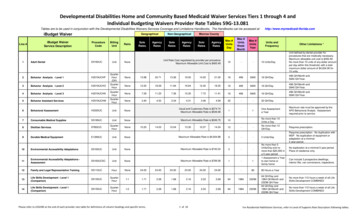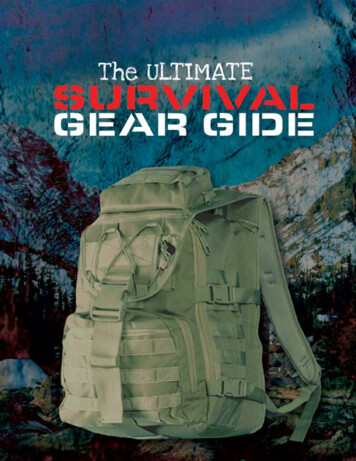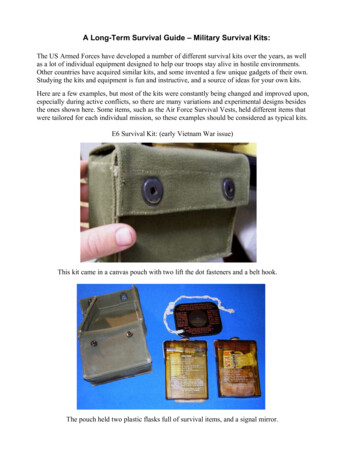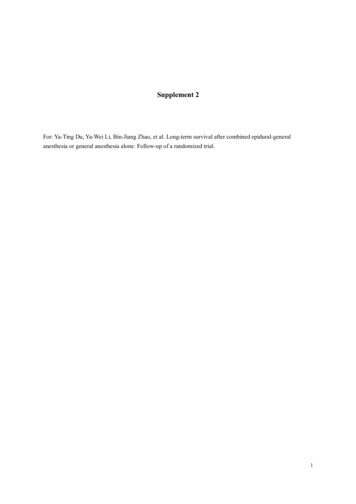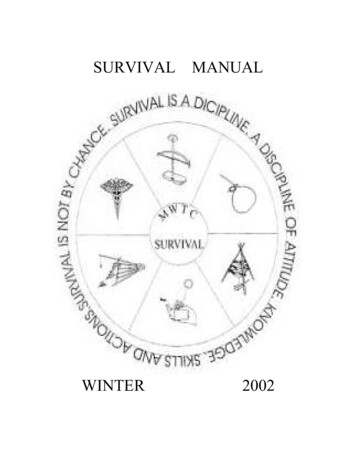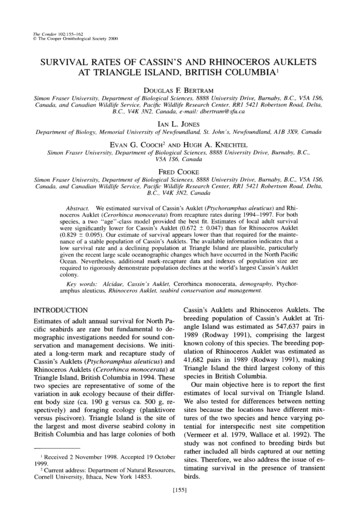
Transcription
The Condor 102: 155-I 620 The Cooper OrnithologicalSowsty 2000SURVIVAL RATES OF CASSIN’SAT TRIANGLE ISLAND,AND RHINOCEROS AUKLETSBRITISH COLUMBIA]DOUGLAS E BERTRAMSimon Fraser University, Department of Biological Sciences. 8888 University Drive, Burnaby, B.C., V5A IS6,Canada, and Canadian WildlifP Service, Pacific Wildlife Research Center, RR1 5421 Robertson Road, Delta,B.C., V4K 3N2, Canada, e-mail: dbertram@sfu.caDepartment of Biology, MemorialIAN L. JONESUniversity of Newfoundland, St. John’s, Newfoundland. AIB 3X9, CanadaEVAN G. COOCH AND HUGH A. KNECHTELSimon Fraser University, Department of Biological Sciences, 8888 University Drive, Burnaby, B.C.,V5A lS6. CanadaFRED COOKESimon Fraser University, Department of Biological Sciences, 8888 Univer&Drive, Burnaby, B.C., VSA lS6,Canada, and Canadian Wildlife Service, Pacijic Wildlife Research Center, RR1 5421 Robertson Road, Delta,B.C., V4K 3N2, CanadaAbstract.We estimatedsurvival of Cassin’s Auklet (Ptychoramphus aleuticus) and RhinocerosAuklet (Cerorhinca monocerata) from recapturerates during 1994-1997. For bothspecies, a two “age’‘-classmodel provided the best fit. Estimates of local adult survivalwere significantly lower for Cassin’s Auklet (0.672 5 0.047) than for Rhinoceros Auklet(0.829 ? 0.095). Our estimate of survival appears lower than that required for the maintenance of a stable population of Cassin’s Auklets. The available information indicates that alow survival rate and a declining population at Triangle Island are plausible, particularlygiven the recent large scale oceanographic changes which have occurred in the North PacificOcean. Nevertheless, additional mark-recapture data and indexes of population size arerequired to rigorously demonstrate population declines at the world’s largest Cassin’s Aukletcolony.Key words: Alcidae, Cassin s‘ Auklet, Cerorhinca monocerata, demography, Ptychoramphus aleuticus, Rhinoceros Auklet, seabird conservation and management.INTRODUCTIONEstimates of adult annual survival for North Pacific seabirds are rare but fundamental to demographic investigations needed for sound conservation and management decisions. We initiated a long-term mark and recapture study ofCassin’s Auklets (Ptychoramphus aleuticus) andRhinoceros Auklets (Cerorhinca monocerata) atTriangle Island, British Columbia in 1994. Thesetwo species are representative of some of thevariation in auk ecology because of their different body size (ca. 190 g versus ca. 500 g, respectively) and foraging ecology (planktivoreversus piscivore). Triangle Island is the site ofthe largest and most diverse seabird colony inBritish Columbia and has large colonies of both’ Received 2 November 1998. Accepted 19 October1999.* Current address: Department of Natural Resources,Cornell University, Ithaca, New York 14853.Cassin’s Auklets and Rhinoceros Auklets. Thebreeding population of Cassin’s Auklet at Triangle Island was estimated as 547,637 pairs in1989 (Rodway 1991), comprising the largestknown colony of this species.The breeding population of Rhinoceros Auklet was estimated as41,682 pairs in 1989 (Rodway 1991), makingTriangle Island the third largest colony of thisspeciesin British Columbia.Our main objective here is to report the firstestimates of local survival on Triangle Island.We also tested for differences between nettingsites because the locations have different mixtures of the two species and hence varying potential for interspecific nest site competition(Vermeer et al. 1979, Wallace et al. 1992). Thestudy was not confined to breeding birds butrather included all birds captured at our nettingsites. Therefore, we also addressthe issue of estimating survival in the presence of transientbirds.[1X5]
156DOUGLAS F. BERTRAM ETAL.For safety reasons,we did not band in rain. Under strong winds the nets would bend, so we didnot trap under those conditions. For Cassin’sAuklet only, we gauged the ages and breedingstatus of birds by scoring the iris color type aswhite, offwhite, light brown, or brown, basedupon minor modifications of the technique ofManuwal (1978). Eye color of Cassin’s Aukletbecomes lighter as the birds age and mature(Emslie et al. 1990). In our study, eye colorsother than white proved to be difficult to scorereliably, and preliminary analyses suggestedthateye color is an imprecise proxy for true age.Note that breeding propensity (and hence recapture rates) of young birds are likely to be lowerthan for older birds. We restricted our analysesto white eyed birds (65% of our sample) becausethis treatment of the data had the least potentialfor results to be confounded by age effects.SURVIVAL ESTIMATIONFIGURE 1. Locationsof netting sitesin West Bay(l), SouthBay (2), and Calamity Cove (3), and thecabin at TriangleIsland,BritishColumbia.METHODSSTUDY AREAWe conducted fieldwork at three study plots onthe south and southwestsides of Triangle Island,British Columbia, Canada (50”52’N, 129”05’W,Fig. 1). The plot at West Bay (1) was located inan area densely occupied by Cassin’s Aukletsonly, the South Bay plot (2) was located justbelow the center of Rhinoceros Auklet’s maincolony (high density Rhinoceros Auklets, lowdensity Cassin’s Auklets), and the CalamityCove plot (3) was located in an area of moderatedensity of both auklet species (Fig. 1).Cassin’s and Rhinoceros Auklets were trappedusing soft plastic “pheasant” nets erected vertically on guyed polyvinyl chloride plastic polesat the base of nesting slopes on the three plots.The net sizes were approximately 15 m X 3 min West Bay and 20 m X 3 m in both South Bayand Calamity Cove. To minimize disturbance tothe study populations, we trapped birds as theydeparted from the colony during the early morning hours (02:OO to 05:30) after most arrivalshad ceased. The nets were usually taken downbefore first light because we were holding asmany birds as could be processedbefore dawn.Local adult annual survival ( ) and recapture (p)rates were estimated using methods described inLebreton et al. (1992) and Burnham and Anderson (1998). We used program MARK (Whiteand Burnham 1999) to model local survival andrecapture rates.Following Bumham and Anderson (1998), wefirst defined a candidate model set, which included a fully parameterized global model. Because our analyses were restricted to birdsmarked as adults, true age effects are unlikely.However, heterogeneity in capture can lead toapparent differences in survival estimated overthe first interval after marking relative to survival estimated over subsequent intervals. To accommodate possible effects of heterogeneity incapture rates among marked individuals, theglobal model was structured to allow survivalduring the first year after marking (first “age”)to differ from survival estimated over subsequent years (2 “age”). Structurally, this isanalogous to age-differences in survival (“age”models, sensu Lebreton et al. 1992). For ourglobal survival model, we used a two “age”class model with site X time-dependence in thefirst year after marking, and constant site-specific survival after the second year followingmarking { Ia2g*t/g}.We did not incorporate timedependenceinto the second “age’‘-class in orderto improve the precision of the estimate becausethe final estimatesfor both “age” classesare notseparatelyidentifiable. Becausebirds were banded
TRIANGLEas unknown aged adults, we did not incorporateage-structureinto the recapture parameter in theglobal model, but allowed for site-specificdifferences (Pset}. The goodness-of-fit (GOF) of theglobal model to the data was determined using aparametric bootstrapapproach(describedbelow).The candidatemodel setincluded the global modeland all possiblereducedparametermodels derivedfrom the global model. The final candidatemodelset included a total of 24 models. Model notationfollowed Lebreton et al. (1992). The factorialstructureof the model is representedby subscripting the primary parameters4 and p using “a” forputative “age” effects,t for time effects,and g forgroup sampling region or speciesdifferences.Relationships among factors were indicated usingstandardlinear models notation.Following Lebreton et al. (1992) and Burnham and Anderson (1998), model selection wasbased on comparison of the quasi Akaike Information Criterion (QAIC,):QAIC,. y 2np 2nP(nP 1)II ess-rtp-1where L is the model likelihood, np is the numberof estimable parameters,II,, is the effective population size, and e is quasi-likelihood adjustmentfor overdispersionin the data. The model likelihoods, number of estimable parameters,and theeffective population size are estimateddirectly bythe program MARK. The quasi-likelihoodparameter was estimated using the mean of simulatedvalues of 2 from the bootstrapGOF testing 1,ooObootstrapsamples(see above). Individual c valuesfor each bootstrappedsample were derived by dividing the bootstrappedmodel GOF x2 by themodel degreesof freedom. E is asymptotically 1.0if the model fits the data perfectly.The model with the lowest QAIC, is acceptedas the most parsimonious model for the data.Comparisons among models in the candidate setwere accomplished by deriving an index of relative plausibility, using normalized Akaikeweights (Burnham and Anderson 1998). Individual model Akaike weights w, were calculated as:ISLANDAUKLETSURVIVAL157where AQAIC, is the absolute numerical difference in QAIC, between a given model and themodel in the candidate model set with the lowestQAIC,. The ratio of wi between any two modelsindicates the relative degree to which a particular model is better supported by the data thanthe other model. To account for uncertainty inmodel selection (Bumham and Anderson 1998),we report parameter estimates 4 and associatedstandard errors derived by averaging over allmodels in the candidate model set, weighted byAkaike model weights sensu Buckland et al.(1997):avg(6) i:i lwj,;where wi reflects the Akaike weight for model i.RESULTSBANDINGSUMMARYNetting effort for Rhinoceros Auklet varied between years (1994: 54 hr; 1995: 81 hr; 1996: 47hr; 1997: 77 hr) and was lowest in 1996, particularly at Calamity Cove, due to constraints imposed by weather. In 1994, five Rhinoceros Auklets which had been banded previously on Triangle Island (three in 1984, one in 1986, one in1989) were recaptured. In 1995 there was a recapture of a bird banded on Triangle Island in1984 which makes it the oldest banded bird onrecord at 1 1 years. In our study, no RhinocerosAuklets were recaptured at locations differentfrom the site of original banding.For Cassin’s Auklet, netting effort also waslowest in 1996 (1994: 63 hr; 1995: 91 hr; 1996:50 hr; 1997: 112 hr). Two birds were recapturedat locations different from the site of originalbanding. One bird, originally banded in 1994 atWest Bay North on 18 June was recapturedagain in 1994 at Calamity Cove on 25 June. Theother, originally banded in 1997 in West Baywas recaptured incidentally at the cabin (Fig. 1)in 1997.SURVIVALANALYSISRhinoceros Auklet. Because 99%of all thecaptures of Rhinoceros Auklets on Triangle Island occurred at Calamity Cove and South Bay,we restricted our analyses to these two sites.From 1994-1996, a total of 843 individualadults were marked and released at these twosites, of which 449 were recapturedat least once
158DOUGLAS F. BERTRAMET Al.TABLE 1. Reduced m-array of Cassin’s Auklet andRhinoceros Auklet marked and recaptured from Triangle Island. Number pooled over all banding sites.SpeciesRhinocerosAukletCassin’s AukletYearR,1995 1996 1997 r;1994478 1.56 44 39199541087 571996 24266156 131 162ml1994888 345 67191995 1,030240 611996600140345 307 220m,23914466431301140R, number of marked indwtduals released in year (I), Including bothnewly marked and previously marked individuals. For example, in 1995,410 marked Rhinoceros Auklets were released. Of these, 254 were newlymarked, 156 were previously marked birds (254 156 410). Annualvalues are the number from a given release cohort first captured m that year(Including newly and previously marked individuals). r, is the total numberof mdividuals from a release cohon captured at least once. m, is the totalnumber of recaptures in a given year.(Table 1). The data satisfactorily fit the two“age’‘-classglobal model {& g*l/gppVt} (P 0.5), with no indication of significant extra-binomial variation in the data (e 1.039 ? 0.039;mean ? SE).The most parsimonious model in the candidate model set was a model where the survivalrates varied with time from 1994-1996 duringthe interval between the year of marking and thenext year (the first “age’‘-class), with no differences between sites (model {4a2ti.pset}; Table 2).Parameter estimates for this “age’‘-class (averaged over all models in the candidate model setto account for uncertainty in model selectionsee Methods) declined monotonically over timeat both Calamity Cove (1994: 0.655 ? 0.044;1995: 0.375 2 0.053; 1996: 0.194 2 0.071) andSouth Bay (1994: 0.651 5 0.043; 1995: 0.383? 0.054; 1996: 0.195 0.070). Adult survival2 years after marking was not different between the two sites (Calamity Cove: 0.844 -C0.098; South Bay: 0.825 0.090; pooled: 0.829-C 0.095). This model was over twice as wellsupported by the data than a model for whichadult survival differed between sites (0.498/0.208 2.4). In contrast, there was significantheterogeneity in recapture rate among years andsites, ranging from 0.26 to 0.53. However, thiswas due entirely to the low recapture rate estimated for Calamity Cove in 1996, which had thelowest total number of netting hours (32 hr in1994; 39 hr in 1995; 21 hr in 1996; 46 hr in1997) and the lowest total number of captures.In general, there was a 40-45% chance of recapturing an individual Rhinoceros Auklet conditional on it being alive and in the samplingarea.Cassin’s Auklet. Because 94% of all thecaptures of Cassin’s Auklets on Triangle Islandoccurred at Calamity Cove and West Bay, werestricted our analyses to these two sites. From1994-1996, a total of 1,866 individuals weremarked and released at these two sites, of which772 were recaptured at least once (Table 1). Aswith the data for Rhinoceros Auklets, the datasatisfactorily fit the two “age’‘-class globalmodel (P 0.19) with no evidence of significant extra-binomial variation in the data (E 1.023 t 0.034).The most parsimonious model (model {4a2F*Upget};Table 3) was a model where the adultsurvival rates varied with (1) time during theyear between the year of marking and the nextyear (the first “age’‘-class), and (2) banding location. Similar to our results for RhinocerosAuklets, survival of Cassin’s Auklets the yearTABLE 2. Summary of model testing for Rhinoceros Auklet banded as adults on Triangle Island, BritishColumbia. Models sorted by increasingQAIC, value. Models with QAIC, weights 0.001 are listed, with themost parsimoniousmodel at the top. Subscriptsreflect different factors in the model (t time, constant,g banding location). The “a2” subscriptrefers to fitting a 2 “age’‘-class model (see text). np number ofestimable 2815.18QAIG1,969.74
TRIANGLEISLANDAUKLETSURVIVAL159TABLE 3. Summary of model testing for Cassin’s Auklet banded as adults on Triangle Island, British Columbia. Models sorted by increasingQAIC, value. Models with QAIC, weights 0.001 are listed, with the mostparsimoniousmodel at the top. Subscriptsas in Table 6.6410.920.010.00;627.5438.51after marking generally declined over time atboth Calamity Cove (1994: 0.604 5 0.035;1995: 0.310 0.036; 1996: 0.295 t 0.069) andWest Bay (1994: 0.576 2 0.030; 1995: 0.23.5 0.026; 1996: 0.174 t 0.047). Adult survival 2 years after marking was constant over time, andnot different between the two sites (CalamityCove: 0.669 2 0.051; West Bay: 0.670 2 0.050;pooled: 0.672 ? 0.047). This model was nearlythree times as well supported by the data than amodel for which adult survival differed betweensites (0.398/0.145 2.7), and also over twice aswell-supported as a model for which time-dependent survival in the year after marking didnot vary between banding locations (0.398/0.179 2.2). As with Rhinoceros Auklets, therewas significant heterogeneity in recapture rateamong years and sites, which ranged from 0.5to 0.7.group effect. We used the Rhinoceros Aukletand Cassin’s Auklet data from Calamity Cove.Calamity Cove was the only site from whichrepresentative samples of both species wereavailable, and for which data for both specieswas adequately fit by the starting model (P 0.5 l), with marginally significant extra-binomialvariation (c 1.117 2 0.036).A model where survival 2 years after marking was allowed to differ between species (i.e.,between groups) was almost three times as wellsupported than a model where survival 2 yearsafter marking was held constant between species(Table 4; 0.59/0.21 2.8). Survival at CalamityCove for Rhinoceros Auklets 2 years aftermarking was estimated at 0.846 -t 0.110, whereas survival for Cassin’s Auklets was 0.685 0.074.INTERSPECIFIC COMPARISONDISCUSSIONTo compare the two species, we fit model {4a2 Our study revealed local adult survival valuess*vgpgAt},treating each species as a separate which were considerably lower (particularly forTABLE 4. Summary of model testing comparing Rhinoceros Auklet and Cassin’s Auklet banded as adults atCalamity Cove on Triangle Island, British Columbia. Models sorted by increasing QAIC, value. Models withQAIC, weights 0.001 are listed, with the most parsimonious model at the top. Subscripts as in Table 2 (exceptg 0131481178.7913.327.667.1825.3720.7830.04
160DOUGLASF. BERTRAMET AL.Cassin’s Auklets) than previous estimates formany other seabird populations. Most auk species for which estimates have been made havesurvival rates in excess of 85% (Gaston andJones 1998). The low adult survival estimate forCassin’s Auklet (0.67) is consistent with a possible decline in population size at the world’slargest colony on Triangle Island based upon independent burrow monitoring, evidence of poorreproductive performance in recent years concurrent with our survival study, and long termdeclines in the California Current zooplanktonand seabird populations. The breeding population was estimated in 1989 using labor-intensivetransect methods but has not been resurveyed(Rodway 1991). However, independent evidencefor a recent population decline is available frominspections of permanent monitoring plots in thecolony. The total number of active burrows in11 permanent monitoring plots declined from2,289 in 1989 to 2,055 in 1994 (2% year’), immediately prior to our survival study (M. Lemon, unpubl. data), a significant decrease basedon within-plot differences (t,, 2.4, P 0.04).A 65% decline of the Cassin’s Auklet populationon the Farallon Islands from 1972-1997 hasbeen linked with an adult annual survival rate(2 SE) of approximately 70 -C 2% for birdsbreeding in artificial nestboxes(Nur et al. 1998).The decline in the Farallon population of Cassin’s Auklet has been linked (Ainley et al. 1996)to a significant long term decline in zooplanktonproduction in the California Current system(Roemmich and McGowan 1995) which has affected the abundance of other seabird populations (Viet et al. 1996). In British Columbia, earlier zooplankton availability (Mackas et al.1998) and low levels of nutrients in surface waters (Whitney et al. 1998) in the 1990s are likelyrelated to recent poor reproductive performancefor Cassin’s Auklet on Triangle Island (pers. observ.). The extent of recent large scale oceanographic changesand their effects on auklet populations thus deservesfurther study. Note that atmore northern locations there is no evidence ofpopulation change or recent reproductive failurefor Cassin’s Auklet populations. In northernBritish Columbia, Gaston (1992) reported localadult survival for year 2 as 0.88 (95% confidence interval 0.73-0.95) for breeding Cassin’sAuklet from a small but stable colony (1,700pairs) at Reef Island. In addition, Cassin’s Auklet reproductive performance on Frederick Is-land in northern British Columbia has been consistently better than at Triangle Island in recentyears (1994-1998; A. Harfenist, pers. comm.).Our survival estimate for the RhinocerosAuklet is the first for the species.The value appears low compared to all available estimatesforAtlantic Puffins (Fratercula arctica; Hudson1985, Harris et al. 1997) which have a similarbody mass and feeding ecology to the Rhinoceros Auklet. There is, however, no independentevidence for a population decline on TriangleIsland. Surveys of five permanent monitoringplots, which were intact before our survivalstudy began, could not detect a significant trendin the number of active burrows in 1984 (494),1989 (589), and 1994 (449; M. Lemon, unpubl.data). Furthermore, Rodway et al. (1992) suggestedthat the extent of the colony expanded onTriangle Island between 1984 and 1989.Additional factors which could contribute tothe observed survival values include possibleemigration, colony attendance patterns, and agestructure effects, but a thorough evaluation ofthese variables must await a longer time series.For both speciesthere was a tendency for survival rate the year following marking to declineover the years of our study. The decline mightreflect a true decrease in survival the year following marking. This might be reasonable if human activity behind the netting areas has increased systematically since 1994, but activitylevels have been similar between 1996 and1997. We therefore think this explanation is unlikely, and argue instead that the decline reflectsan artifact of the sampling design in our study.We suggest that the decline may reflect an interannual decline in the proportion of transientsin our sample of banded birds. Assume that thepopulation has a constant ratio of residents totransients and that both groups are captured inproportion to their overall frequency in the population. In the first year of captures, the ratio ofresident to transientswill be maximal. With eachadditional year, as the proportion of bandedbirds in the sample increases, the proportion ofresidentsto transientsis likely to decline at somerate and hence the apparent survival will alsodecline, as we observed (Appendix).In conclusion, our intensive study providesfirst estimatesof local survival for Cassin’s Auklet from their largest colony, and the first survival estimate for the Rhinoceros Auklet. Forboth species, the survival estimates were lower
TRIANGLEISLANDAUKLETSURVIVAL1611997. Model selection: an integral part of inferthan most estimatesfor auk species.For Cassin’sence. Biometrics 53:603-618.Auklet, the low survival rates are consistentwithBURNHAM, K. I?, AND D. R. ANDERSON. 1998. Modela current population decline as has been obselection and inference-apractical informationserved on the Farallon Islands (Nur et al. 1998),theoretic approach. Spring-Verlag, New York.but additional data are required to validate the EMSLIE, S. D., R. l? HENDERSON,AND D. G. AINLEY.1990. Annual variation of primary molt with agesuspectedtrend on Triangle Island. The possiand sex in Cassin’s Auklet. Auk 107:689-695.bility of a population decline is compelling parGASTON, A. J. 1992. Annual survival of breeding Casticularly in light of the recent large-scale oceansin’s Auklets in the Queen Charlotte Islands, Britographic changesin the northeast Pacific and itsish Columbia. Condor 94: 1019-1021.documented effects on marine trophic webs GASTON, A. J., AND I. L. JONES. 1998. Bird families ofthe world: the Auks (Alcidae). Oxford Univ.(Roemmich and McGowan 1995, Mackas et al.Press, Oxford.1998). As the mark-recapture program continHARRIS, M. P, S. N. FREEMAN, S. WANLESS, B. J. T.ues, the local survival estimates will becomeMORGAN, AND C. V. WERNHAM. 1997. Factors inmore robust and comparisonsof interannual varfluencing the survival of Puffins Frutercula urctica at a North Sea colony over a 20.year period.iability will be facilitated. We plan to examineJ. Avian Biol. 28:287-295.the relationship between variation in prey availHUDSON, l? J. 1985. Population parameters for the Atability and breeding propensity to investigate thelantic Alcidae, p. 233-261. In D. N. Nettleshipeffects of breeding avoidance on the magnitudeand T R. Birkhead [EDS.], The Atlantic Alcidae.of estimates of survival. By coupling the survivAcademic Press, Orlando, FL.al estimates with regularly obtained indexes of LEBRETON,J.-D., K. I? BURNHAM, J. CLOBERT, AND D.R. ANDERSON. 1992. Modelling survival and testpopulation size (Rodway et al. 1992, Bertram eting biological hypotheses using marked animals:al. 1999), with a program which examines vara unified approach with case studies. Ecol. Moniation in reproductive success,we will be ableogr. 62:67-l 18.to quantify population trends and their causes MACKAS, D. L., R. GOLDBLATT,AND A. G. LEWIS. 1998.Interdecadal variation in developmental timing ofand thus make robust predictions about the fuNeocalanus plumchrus populations at Ocean Stature status of the populations.ACKNOWLEDGMENTSThe British Columbia Ministry of Environment Landsand Parks provided the permit to work on the AnneVallCe Ecological Reserve, Triangle Island. We thankthe many volunteers and technicians for assistancewith auklet capture-recapture. Connie Smith helpedcollate and organize the dataset. We thank the Canadian Wildlife Service (CWS) and particularly GaryKaiser for providing funding in 1994 and continuedlogistic support. Moira Lemon (CWS) kindly providedunpublished data on monitoring plot surveys. Financialsupportwas provided by Natural Sciences and Engineering Research Council (NSERC) of Canada grantsto FredYCooke and Tony W illiams and from the ?WS/NSERC Research Chair of Wildlife Ecology at SimonFraser University. Construction of the research stationwas made possible by a generous grant from the Vancouver Foundation. We are indebted to the CanadianCoast Guard for essential ship and helicopter support.LITERATURECITEDAINLEY, D. G., L. B. SPEAR, AND S. G. ALLEN. 1996.Variation in the diet of Cassin’s Auklet revealsspatial, seasonal, and decadal occurrence patternsof euphausiids off California, USA. Mar. Ecol.Prog. Ser. 137:1-10.BERTRAM, D. F., L. COWEN, AND A. BURGER. 1999. Useof radar for monitoring colonial burrow-nestingseabirds. J. Field Ornithol. 70:145-157.BUCKLAND, S. T., K. P. BURNHAM, AND N. H. AUGUSTIN.tion P in the subarctic North Pacific. Can. J. Fish.Aquat. Sci. 55:878-1893.MANUWAL, D. A. 1978. Criteria for aging Cassin’sAuklets. Bird Banding 49:157-161.NUR, N., W. J. SYDEMAN, M. HESTER, AND P PYLE.1998. Survival in Cassin’s Auklets on SoutheastFarallon Island: temporal patterns, population viability, and the cost of double brooding. PacificSeabirds 25:38. (Abstract)RODWAY, M. S. 1991. Status and conservation ofbreeding seabirds in British Columbia. Int. Council Bird Preserv. Tech. Publ. No. 11:43-102.RODWAY, M. S., M. J. E LEMON, AND K. R. SUMMERS.1992. Seabird breeding populations in the ScottIslands on the west coast of Vancouver Island,1982-89, p. 52-59. In K. Vermeer, R. W. Butler,and K. H. Morgan [EDS.], The ecology, status, andconservation of marine and shoreline birds on thewest coast of Vancouver Island. Occas. Paper No.75. Can. Wild. Serv., Ottawa.ROEMMICH, D., AND J. MCGOWAN. 1995. Climatewarming and the decline of zooplankton in theCalifornia Current. Science 267: 1324-1326.VEIT, R. R., F? PYLE, AND J. A. MCGOWAN. 1996.Ocean warming and long-term change in pelagicbird abundance within the California Current system. Mar. Ecol. Prog. Ser. 139:1 l-18.VERMEER, K., R. A. VERMEER, K. R. SUMMERS,AND R.D. BILLINGS. 1979. Numbers and habitat selectionof Cassin’s Auklets breeding on Triangle Island,British Columbia. Auk 96: 143-15 1.WALLACE, G. E., B. COLLIER, AND W. J. SYDEMAX1992. Interspecific nest-site competition among
162DOUGLASF. BERTRAMET AL.cavity-nesting alcids on Southeast Farallon Island,California. Colonial Waterbirds 15 :24 l-244.WHITE, G. C., AND K. P BURNHAM. 1999. ProgramMARK-survivalestimation from population ofmarked animals. Bird Study 46, in press.WHITNEY, E A., C. S. WONG, AND l? W. BOYD. 1998.Interannual variability in nitrate supply to surfacewaters of the Northeast Pacific Ocean. Mar. Ecol.Prog. Ser. 170: 15-23.APPENDIXTo demonstrate the effects of (1) constant total sample size and (2) constant proportions of resident andtransient individuals on apparent survival over the firstinterval after marking, we consider a population consisting of 1,000 individuals, of which there are 80%resident and 20% transient individuals in all years. Weassume that in each year, 50% of all individuals in thepopulation are captured. True annual adult survival isset at I 0.8. If p 1.0, then we can show algebraically that apparent survival over the first interval, estimated as proportion of newly banded birds releasedin year (i) seen again in year (i 1) decreases from0.64 in the first year ({400 0.8}/500, where 500 400residents 100 transients marked and released), to0.51 in the third year. The proportion recaptured increases from 0% in year 1 to 45% in year 3, approximately equal to that observed in our study for Rhinoceros Auklets. Ultimately, the first interval survivalrate asymptotes, coincident with the point at which theproportion of recaptures in the banding sample no longer increases (Figure below).If the sampling fraction is increased from 50% to70%, then first interval sur
Rhinoceros Auklet marked and recaptured from Tri- angle Island. Number pooled over all banding sites. Species Year R, 1995 1996 1997 r; Rhinoceros 1994 478 1.56 44 39 239 Auklet 1995 410 87 57 144 1996 242 66 66 ml 156 131 162 Cassin’s Auklet 1994



